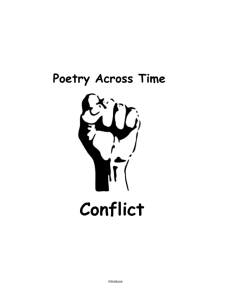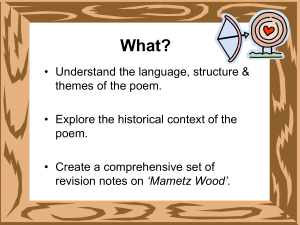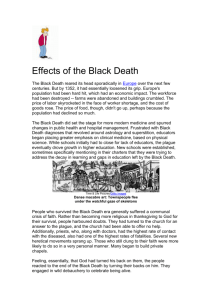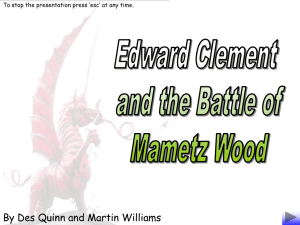Mametz Wood by Owen Sheers
advertisement
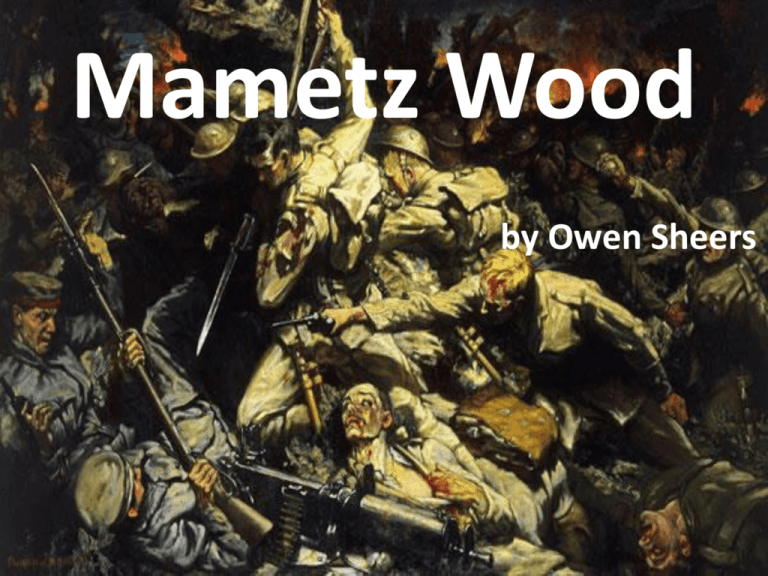
Mametz Wood by Owen Sheers Today we are learning to … … analyse and interpret the poem Mamtez Wood by Owen Sheers A background to the poem • Battle of the Somme: 1st July – 18th November 1916. • An offensive by British/French armies against German army. • One of the largest battles of WWI with over 1 million casualties (60,000 on first day alone)– one of the bloodiest military operations ever recorded. • Mametz Wood – objective of 38th Welsh Division as part of this larger battle. • Battle lasted 7-12 July 1916. • About 4000 casualties. In this battle, the poet Siegfried Sassoon made single-handed attack on enemy trenches – awarded M.C. and nickname ‘Mad Jack’. The battle raged for five days; Mametz Wood was devastated as artillery shells fell continuously. Fighting was furious, with much hand-to-hand combat, as men battled for every inch of land. The poet Robert Graves also fought in the battle and, having returned to the wood once the battle was over, wrote: "It was full of dead Prussian Guards, big men, and dead Royal Welsh Fusiliers and South Wales Borderers, little men. Not a single tree in the wood remained unbroken." The Welsh at Mametz Wood by Christopher Williams Moonrise over Mametz Wood by William Thurston Topham Mametz Wood : after the autumn advance, 1916. 'The abomination of desolation‘. by J . B. Morrall Owen Sheers • Welsh poet, author and scriptwriter • Born in Fiji, 1974 • Won and shortlisted for many awards for his writing. • ‘Mametz Wood’ from his Skirrid Hill collection. The writer uses the poem to show us that WWI, much written about over the years , still haunts us almost a century later – tragedy of loss and life. Was their sacrifice worthwhile? For years afterwards the farmers found them – the wasted young, turning up under their plough blades as they tended the land back into itself. Mametz Wood A chit of bone, the china plate of a shoulder blade, the relic of a finger, the blown and broken bird’s egg of a skull, all mimicked now in flint, breaking blue in white across this field where they were told to walk, not run, towards the wood and its nesting machine guns. And even now the earth stands sentinel, reaching back into itself for reminders of what happened like a wound working a foreign body to the surface of the skin. CLICK HERE TO PLAY This morning, twenty men buried in one long grave, a broken mosaic of bone linked arm in arm, their skeletons paused mid dance-macabre in boots that outlasted them, their socketed heads tilted back at an angle and their jaws, those that have them, dropped open. As if the notes they had sung have only now, with this unearthing, slipped from their absent tongues. by Owen Sheers Guardian Article: read handout Although this isn’t the same place, it is the same event that Sheers writes of. LINK HERE What sorts of things did the farmers find in their fields in stanzas 1–3? Who? When do we realise? Begins in past tense For years afterwards the farmers found them – the wasted young, turning up under their plough blades as they tended the land back into itself. What function does the dash serve? Plosives : sounds often associated with p, t, k, b, d, g - air flow from lungs interrupted by complete closure in the mouth. Fricatives sounds often associated with f, s; v, z - air passes through narrow constriction causing a noisy sound. Strong alliterative B here – what effect? A chit of bone, the china plate of a shoulder blade, the relic of a finger, the blown Birds eggs preserved by a hole in either and broken bird’s egg of a skull, making end and blowing out the contents. Various meanings including: - a child/young person - an IOU note or short note - when potatoes are prepared for planting What other references to birds can you find? Why do many war writers use birds as symbolism? What do the metaphors in this stanza suggest? ‘Returning, We Hear the Larks’ by Isaac Rosenberg (a poem) Stills from the film version of ‘All Quiet On The Western Front’ – a novel written by Erich Maria Remarque- a German soldier in WWI – a soldier is inspired by birds. Watch the film: http://www.youtube.com/watch?v=gOTWPSJdxRw&list=PLD585623CD8FA8E5F Some claim Vaughan Williams’s classical music piece ‘The Lark Ascending’ written in 1914 was inspired to write this as he watched the troops leaving for France. Listen to it here: http://www.youtube.com/watch?v=ZR2JlDnT2l8&feature=kp Enjambement between stanzas 2-3 – WHY? Hard mineral that often fossilises & preserves what it forms around. Produces sparks when struck against steel. Old fashioned crockery colours, also the common colours of flint. all mimicked now in flint, breaking blue in white across this field where they were told to walk, not run, towards the wood and its nesting machine guns. Compare time periods covered by stanzas 1–3 and stanzas 5–7. What do you notice? Why is this stanza placed in the middle of the poem? Personification: what human characteristics are given to the earth? What does this suggest about nature / fate of the soldiers / modern attitudes to WWI? How would the earth ‘feel’ to see what is happening? Repetition of ‘now’; shift to present tense. And even now the earth stands sentinel, reaching back into itself for reminders of what happened like a wound working a foreign body to the surface of the skin. Simile: what does this comparison suggest? Irony: literally a foreign body – reminiscent of Rupert Brooke’s ‘The Soldier’? Read the first column of quotations, then try to match each of them with a quotation from the second column. When you have found the matching pairs, fill in the final column explaining how they are connected. Quotation (1) Quotation (2) ‘the china plate of a shoulder blade’ ‘nesting machine guns’ ‘the blown/and broken bird’s egg of a skull’ ‘a broken mosaic of bone’ ‘like a wound working a foreign body to the surface of the skin’ ‘tended the earth back into itself’ How are they linked? Quotation (1) Quotation (2) ‘the china plate of a shoulder blade’ ‘nesting machine guns’ ‘the blown/and broken bird’s egg of a skull’ ‘a broken mosaic of bone’ ‘like a wound working a foreign body to the surface of the skin’ ‘tended the earth back into itself’ How are they linked? Insistent reminder of the Present: suggests a new discovery of the past This morning, twenty men buried in one long grave, a broken mosaic of bone linked arm in arm, their skeletons paused mid dance-macabre Metaphor: suggesting what? Danse Macabre: AKA ‘Dance of Death’ – a theme of much medieval art/poetry which depicts the universality of death with skeletons leading all ranks of people to their deaths. It symbolises death as the great equaliser; that wealth/material possesions, power and beauty are fleeting. See next slides for pictures… Danse Macabre Danse Macabre Danse Macabre Enjambement between stanzas 5-6 – WHY? Poignant that the boots are more durable than the men Shocking and graphic image of the skulls. in boots that outlasted them, their socketed heads tilted back at an angle and their jaws, those that have them, dropped open. A disturbing aside - hints at lack of voice? Poet offers his interpretation? Perfect past tense: means that the singing took place before any of the other events referred to. Why mention the ‘oldest’ event right at the end of the poem? As if the notes they had sung have only now, with this unearthing, slipped from their absent tongues. What might the poet be trying to indicate here? Image of loss – also compare to jaws discussion in stanza 6 PAST AND PRESENT: quick task 1. Highlight: • Verbs in simple past tense (ending –ed) • Verbs in present tense • Verbs in past perfect tense (using ‘had’). 2. What does this task reveal about the division between past and present? 3. Does this alter your initial interpretation of the poem?
